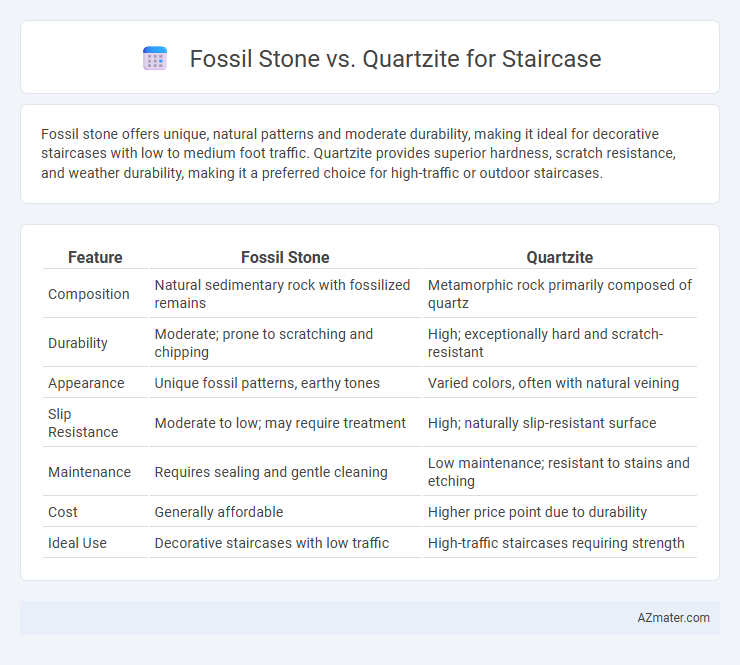Fossil stone offers unique, natural patterns and moderate durability, making it ideal for decorative staircases with low to medium foot traffic. Quartzite provides superior hardness, scratch resistance, and weather durability, making it a preferred choice for high-traffic or outdoor staircases.
Table of Comparison
| Feature | Fossil Stone | Quartzite |
|---|---|---|
| Composition | Natural sedimentary rock with fossilized remains | Metamorphic rock primarily composed of quartz |
| Durability | Moderate; prone to scratching and chipping | High; exceptionally hard and scratch-resistant |
| Appearance | Unique fossil patterns, earthy tones | Varied colors, often with natural veining |
| Slip Resistance | Moderate to low; may require treatment | High; naturally slip-resistant surface |
| Maintenance | Requires sealing and gentle cleaning | Low maintenance; resistant to stains and etching |
| Cost | Generally affordable | Higher price point due to durability |
| Ideal Use | Decorative staircases with low traffic | High-traffic staircases requiring strength |
Introduction to Fossil Stone and Quartzite
Fossil stone, a natural sedimentary rock rich in preserved marine fossils, offers a unique, textured appearance ideal for distinctive staircase designs. Quartzite, a hard metamorphic rock formed from sandstone, provides exceptional durability and a consistent, glassy finish, making it a preferred choice for high-traffic staircases. Both materials combine aesthetic appeal and strength, but Fossil stone emphasizes natural fossil patterns while Quartzite prioritizes hardness and resistance to wear.
Defining the Material: What is Fossil Stone?
Fossil stone is a natural sedimentary rock composed primarily of embedded fossilized remains, giving it a unique texture and pattern ideal for decorative staircases. This material showcases preserved ancient marine organisms, which make each slab visually distinct and rich in historical value. Quartzite, in contrast, is a hard metamorphic rock known for its durability and resistance to wear, commonly chosen for staircases requiring long-lasting strength and minimal maintenance.
Understanding Quartzite: Key Characteristics
Quartzite, a natural metamorphic rock formed from sandstone, exhibits exceptional hardness and durability, making it highly suitable for staircases. Its resistance to scratches, heat, and stains surpasses that of fossil stone, ensuring long-lasting performance under heavy foot traffic. The unique crystalline texture and subtle color variations in quartzite add aesthetic value while maintaining structural integrity.
Visual Appeal: Texture and Color Variations
Fossil stone offers unique visual appeal with intricate shell and organic patterns that create a distinctive, natural texture, making each staircase truly one-of-a-kind. Quartzite provides a more consistent texture with subtle veining and a range of color variations from soft whites to deep grays, enhancing modern and elegant design schemes. Both materials boast durability, but fossil stone's rich historical patterns contrast with quartzite's sleek, polished look to suit different aesthetic preferences.
Durability and Strength Comparison
Fossil stone offers moderate durability with unique fossil impressions adding aesthetic value while maintaining reasonable resistance to wear and scratches. Quartzite, known for its exceptional hardness and density, outperforms fossil stone in strength, providing superior resistance to impacts, heat, and heavy foot traffic, making it ideal for high-use staircases. Choosing quartzite ensures a longer-lasting, low-maintenance staircase with enhanced structural integrity compared to fossil stone.
Maintenance Requirements for Staircases
Fossil stone requires regular sealing and gentle cleaning with pH-neutral products to prevent surface damage and preserve its unique fossil patterns. Quartzite offers superior durability with minimal maintenance, needing only occasional cleaning and resealing to maintain its hardness and resistance to scratches. Both materials benefit from prompt spill cleanup to avoid staining, but quartzite's natural hardness makes it more forgiving for high-traffic staircase areas.
Slip Resistance and Safety Factors
Fossil stone offers moderate slip resistance suitable for residential staircases but may require textured finishes to enhance safety in high-traffic areas. Quartzite provides superior hardness and naturally high slip resistance, making it an excellent choice for balancing durability and safety on stair treads. Optimal staircase safety involves evaluating surface texture, coefficient of friction, and maintenance requirements for both materials.
Cost Analysis: Installation and Long-Term Value
Fossil stone typically has a lower initial cost for staircase installation compared to quartzite, making it a budget-friendly option for homeowners. Quartzite, although more expensive upfront, offers superior durability and resistance to scratching and staining, contributing to lower maintenance expenses and longer lifespan. Over time, the higher investment in quartzite translates into greater long-term value and cost savings due to reduced need for repairs and replacements.
Environmental Impact and Sustainability
Fossil stone, being a natural sedimentary rock formed over millions of years, has a lower environmental impact due to its minimal processing compared to quartzite, which requires intense heat and pressure for formation and significant quarrying energy. Quartzite's durability offers long-term sustainability by reducing the need for frequent replacements, but its extraction often leads to higher habitat disruption and carbon emissions. Choosing fossil stone supports sustainability through lower embodied energy and promotes conservation of natural resources, while quartzite provides longevity with a higher initial environmental footprint.
Conclusion: Choosing the Right Material for Your Stairs
Fossil stone offers unique, natural patterns with a softer texture suited for decorative staircases, while quartzite provides superior hardness and durability ideal for high-traffic areas. Quartzite's resistance to scratches, heat, and stains makes it a practical choice for long-lasting stair surfaces requiring minimal maintenance. Selecting between fossil stone and quartzite depends on balancing aesthetic preferences with functional demands, prioritizing durability for safety and longevity in stair design.

Infographic: Fossil stone vs Quartzite for Staircase
 azmater.com
azmater.com